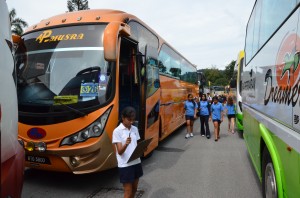Sustainability Education in Classrooms

Originally appears in the Winter 2012-2013 issue
Pick a class. Any class. The teacher looks around at the students and asks a simple question: “What can we do, right here and now, to make a positive difference in our community as it relates to [insert curricular topic here]?” During a rather intense deliberation in a 10th grade health class studying environmental health at the International School of Kuala Lumpur (ISKL), a student responded with a question of her own, “What about the busses? They just sit there pumping out fumes just so they can be cool when we get on. If you’re outside waiting for your bus to arrive all you get is smoke in your face. Can’t we find out if there is a relationship between the amount of idling and the number of respiratory cases in the health services offices?” Another announced, “Every year we talk about saving energy but use goes up and up. Why don’t we find out how much is used by our school’s servers and see if we can cut down their use at night when no one is using their computers? I don’t think much energy in Malaysia comes from renewable resources and pollution is a problem.”
Back and forth such brainstorming sessions continue until the class agrees on the topic they want to tackle. A flurry of activity ensues: investigation, data collection and analysis, interviews, looking at the issues from environmental, social and economic perspectives, formulating strategies and developing innovations for positive change. The end results are as varied as the creativity of youth. But they all have one thing in common: a chance for students to become empowered in making their own school or community a more sustainable place through the use of what, at ISKL, we call the Education for Sustainable Development (ESD) framework.
The ESD framework is engaging, challenging, authentic and powerful. In classrooms where it is utilized students don’t simply learn about sustainability, they actively recognize the powerful relationship between collaborative planning and sustainable change. For teachers, the ESD framework allows a flexible tool for introducing ESD into any curricular topic at any level. It’s possible to structure an entire unit around it, but it’s also practical for teachers to utilize only the portions of the framework that are useful for their needs.
This content is restricted to subscribers only.
If you are not yet a subscriber, please consider taking out a subscription here.
If you are an existing subscriber, kindly log in or contact us at info@greenteacher.com for more information.





